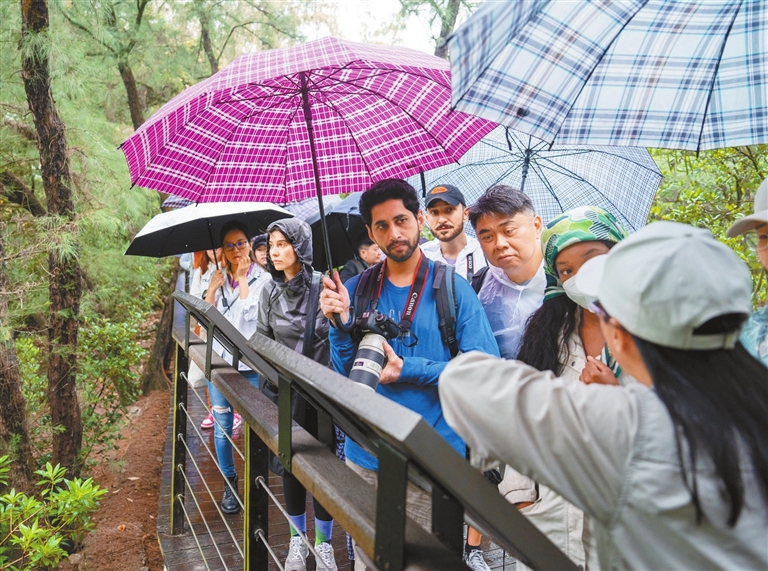
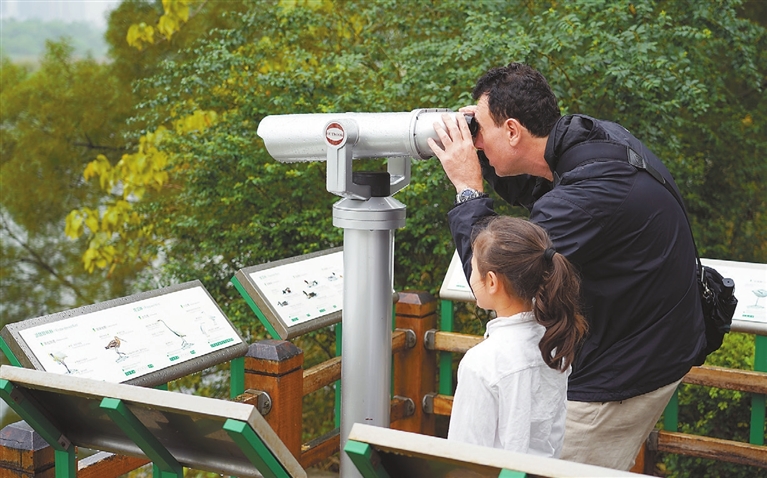
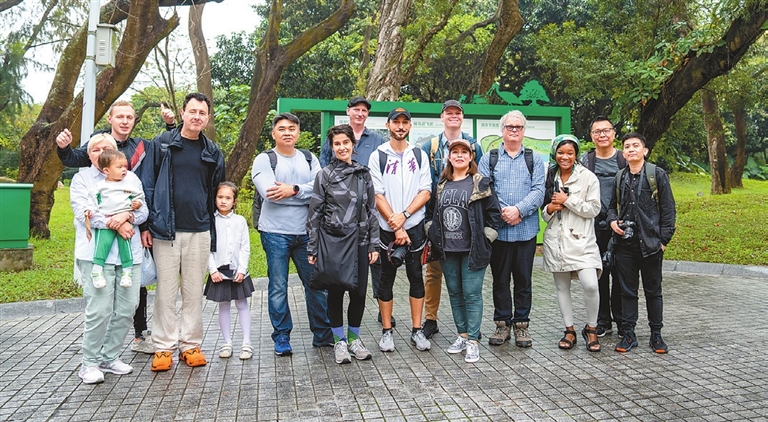
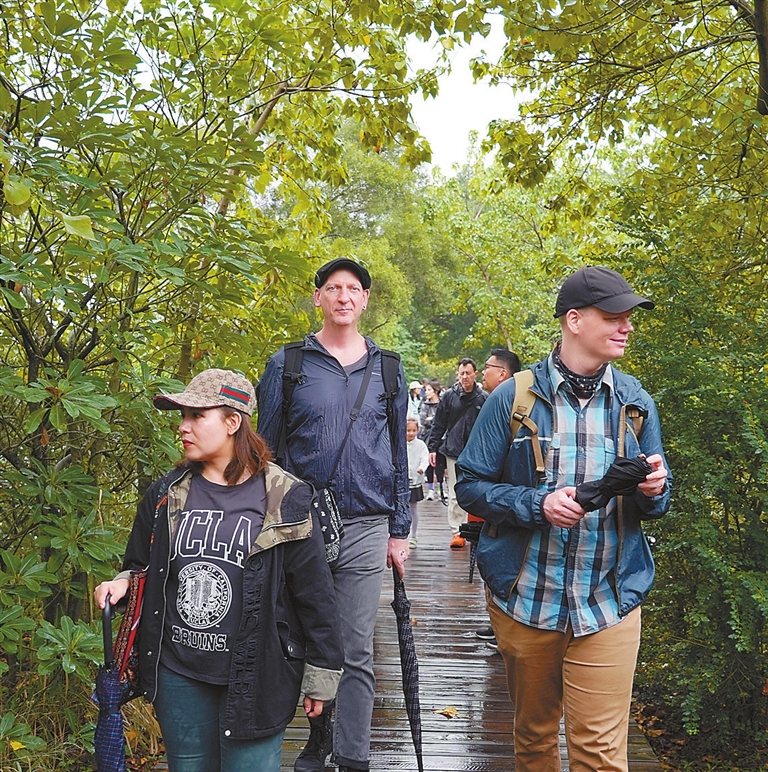

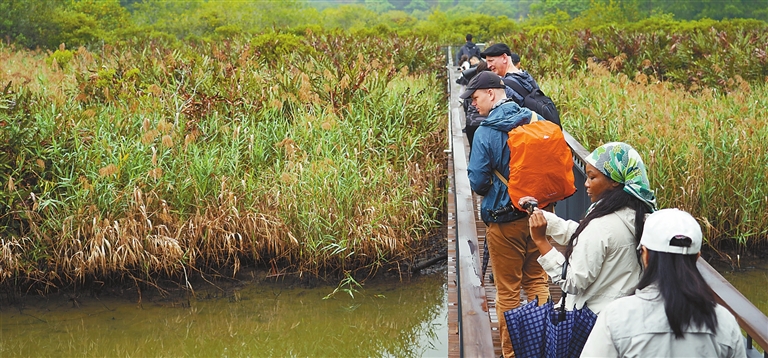
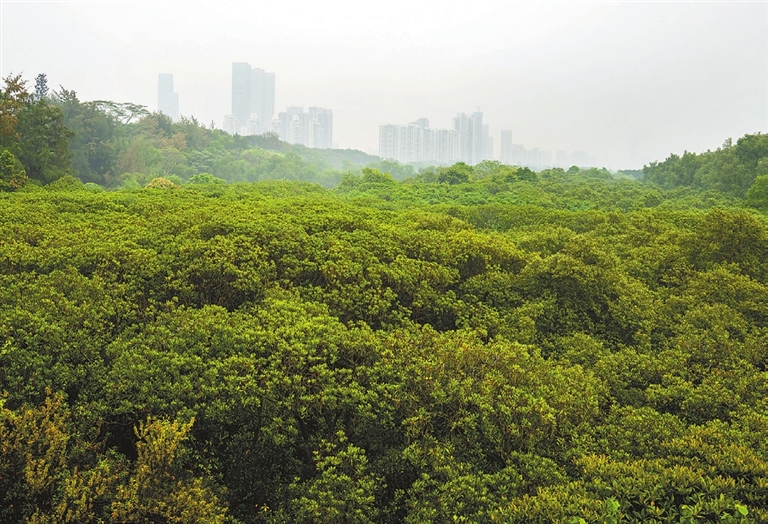
Yang Mei yangmei_szdaily@163.com ON a drizzling Sunday afternoon, a group of about 20 expat photographers and nature enthusiasts from 12 countries briefly escaped the urban jungle and embarked on a trip to an urban oasis — Futian Mangrove National Nature Reserve, located in the northeast part of Shenzhen Bay. The event was organized by EYESHENZHEN.COM and Shenzhen Daily, and supported by the Guangdong Neilingding Futian National Nature Reserve Administration. Guided by Dr. Yang Qiong, professor of engineering at the Guangdong Neilingding Futian National Nature Reserve Administration, the group, consisting of expats from the U.S., the U.K., Russia, Australia, Singapore, Malaysia, Japan, the Czech Republic, Italy, the Philippines, Bolivia, and Pakistan, walked through the dense mangrove forests. They stopped at several points to learn about mangroves, and admire and capture the beauty of the unique ecosystem with their cameras. Yang explained to the visitors the history of the nature reserve and the importance of mangroves to the coastal ecosystem. She also highlighted the need for conservation and restoration efforts to protect mangrove forests from human activities such as logging and fishing. Yang also pointed out various bird species that call the reserve home. Along the way, the expats used a telescope to watch a flock of birds preening and foraging in gei wai (excavated ponds used for shrimp and fish farming), including common redshanks, dunlins, common moorhens, little egrets and grey herons. Via a real-time video monitoring system at a bird-watching pavilion, the sightseers spotted black-faced spoonbills perching on the branches of the mangroves. Soon afterwards on their way back, they encountered and were wowed by a great egret flying over the lush mangrove forests, and some of them quickly raised their cameras, attempting to snap shots of the elegant, dazzling white bird. For Teo Wei Tiong, a Singaporean who has been living in Shenzhen for almost 20 years, the trip was an educational, refreshing and enjoyable experience. “The trip is very educational because it’s like having some new lessons for us. At the same time, it’s refreshing with the rain, and we see a lot of green, so it’s also enjoyable,” he said. Teo said he also gained a newfound perspective of different species of mangroves and the preservation efforts of the government and the reserve. Husnain Raza, a postdoctoral research fellow at Shenzhen University’s Institute for Advanced Study, who studies food science and engineering, said he was “shocked” to see a nature reserve in the center of the city, adding that he was inspired by what he had learned about the mangroves for his research. (Continued on P2; More photos on P3) (From Page 1) “I’m working on rice starch. We know rice is one of the reasons for diabetes because it is readily digested and can raise blood sugar. So, I’m wondering that maybe we could extract the starch of tannins from mangroves to make some product to reduce digestion,” Raza explained. Enza Migliore, an assistant professor from the School of Design at Southern University of Science and Technology (SUSTech), told Shenzhen Daily that she was very impressed about the tranquility and the quality of air in the reserve. “It’s very impressive that in the middle of the crowded technological city, we have such a quiet place where you can really breathe the fresh air and admire the beauty of the mangroves,” Migliore said. The Italian said she appreciates the city government’s efforts to shift from a human-centered development approach towards urban nature spaces to prioritize the protection of birds. Migliore suggests that the reserve could improve the design of its facilities such as the manmade walking trails to make people a part of nature instead of being an obvious observer. Spanning about 9 kilometers along the coastline with a total area of 367.6 hectares, the nature reserve is the smallest mangrove reserve in China and the only national nature reserve in urban areas in China. According to the reserve’s official website, the reserve is home to a diverse range of flora and fauna, including 16 native mangrove species, which are an essential part of the coastal ecosystem. The reserve also serves as a wintering site and stopover for nearly 100,000 migratory birds every year. On Feb. 2, the Futian Mangrove National Nature Reserve was recognized as a Wetland of International Importance under the Ramsar Convention. The Shenzhen Municipal Public Works Bureau recently released an open tendering for the design of the exhibition part of the Shenzhen Mangrove Wetland Museum. The national-level museum will be located at the junction of Shenzhen Bay coastal reclamation zone and the corridor featuring both mountains and seas, and is close to major urban facilities and areas such as the mangrove nature reserve, Shenzhen Bay Park, Shenzhen International Garden and Flower Expo Park and the Futian integrated transportation hub. China proposed establishing an international mangrove center in Shenzhen as an important site for global mangrove preservation and cooperation on Nov. 5 last year. A draft resolution in this regard was officially passed at the 14th Meeting of the Conference of the Contracting Parties to the Ramsar Convention on Wetlands (COP14) on Nov. 13, 2022. | 
